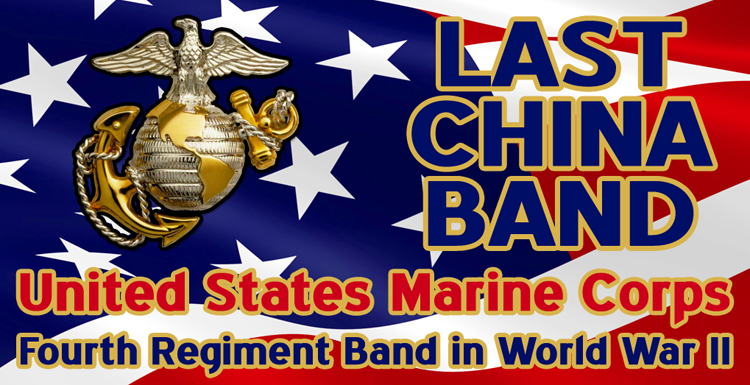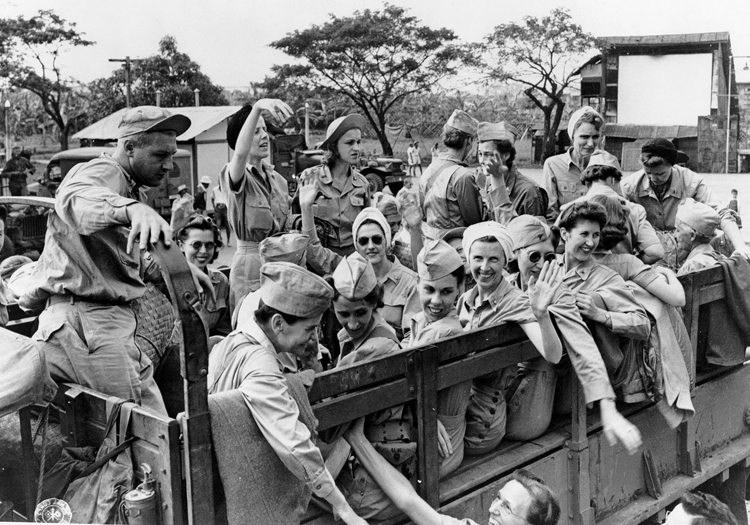
Angels of Bataan
US Army and Navy
WWII POW Nurses
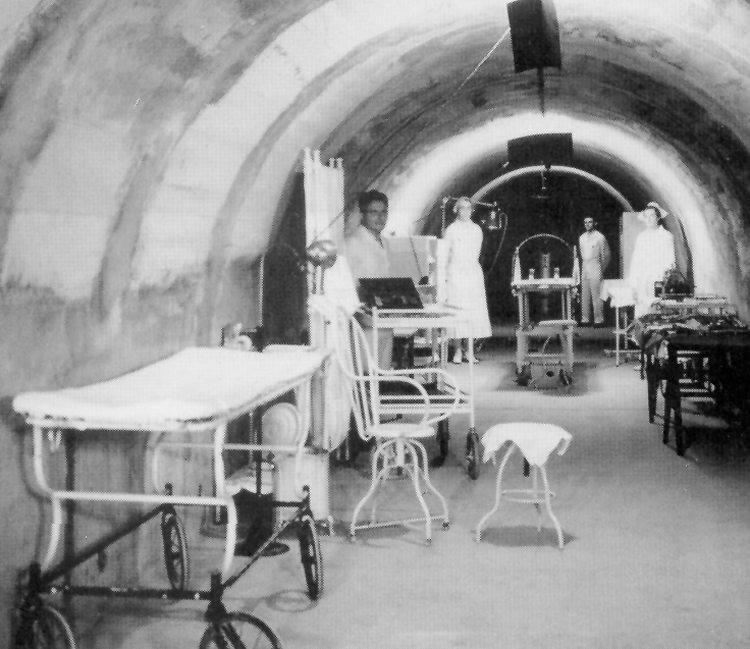
Malinta
Tunnel Hospital
Corregidor Island, Philippines |
|
|
In the autumn of 1941, the
Philippines was a gardenia scented paradise for the American Army and
Navy nurses stationed there. War was a distant rumor, life a routine of
easy shifts and dinners under the stars. On December 8 all that
changed, as Imperial Japanese bombs began raining down on American
bases in Luzon, just ten hours after the attack on Pearl Harbor, and
this paradise became a fiery hell. Caught in the raging battle, the
nurses set up field hospitals in the jungles of the Bataan Peninsula
and the tunnels of Corregidor Island, where they tended to the most
devastating injuries of war, and suffered the terrors of shells and
shrapnel. But the worst was yet to come.
After Bataan
and Corregidor fell, 66 US Army and 11 US Navy nurses were herded into
Santo Tomas University internment camp in Manila, capital city of the
Philippine Islands, the Navy personnel later being transferred to Los
Banos, where organized to continue to apply their medical skills for
all in the camps, they would endure three years of fear, brutality, and
starvation. Once liberated, all having survived the war, returned to an
America that at first celebrated them, but later denied them the
veterans benefits that they deserved. |
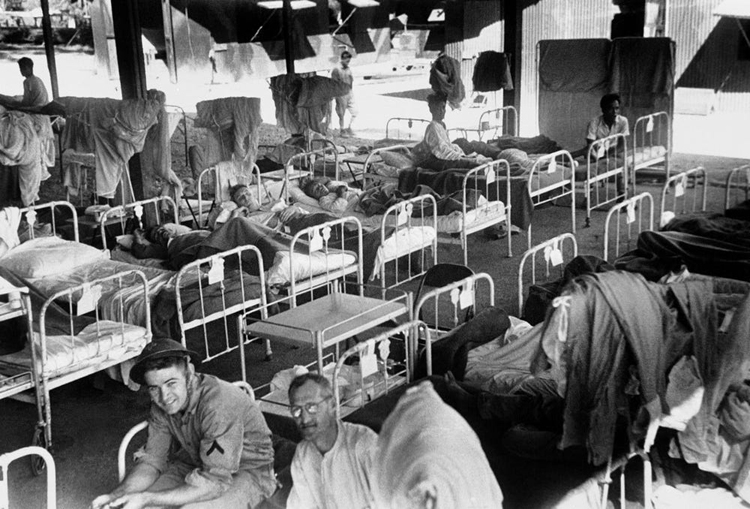 |
| April
11, 1942 US and Filipino Troops, Victims of Japanese Bombing Attacks on
Bataan Peninsula, Philippines, in Open Air Field Hospital After
Receiving Medical
Treatment |
 |
| Santo Tomas University, Manila Internment Camp |
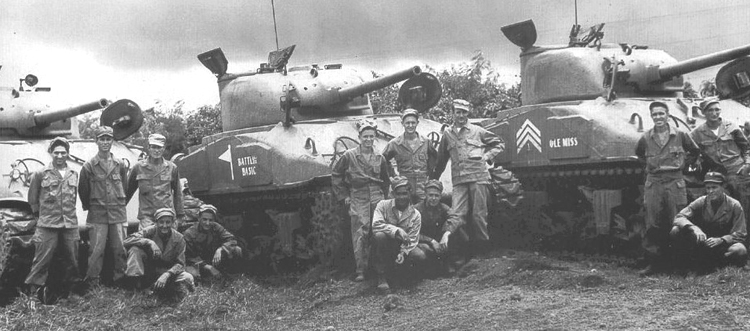 |
| M4 Sherman Tanks Liberation of Santo Tomas 1945 |

|
On
the evening of February 3, 1945, a Sherman tank barreled its way
through the front gates of the University of Santo Tomas, in Manila,
Philippines. The tank, a composite hull M4 Sherman named the “Battlin
Basic” by its crew, belonged to Company B of the U.S. 44th Tank
Battalion and was the first glimpse of liberation for over 4,000
civilians – mostly Americans and British citizens, including
Australians and Canadians – interned at the university from January
1942 to February 1945. Santo Tomas was the largest of several
internment camps established by the Japanese throughout the Philippines.
Santo Tomas Raid
By Peter R. Wygle*
One
of the most awe-inspiring yet historically little remembered missions
of World War II in the Pacific were the four rapid-fire prisoner of war
liberation raids in the Philippines. These four raids, Bilibid,
Cabanatuan, Santo Tomas, and Los Banos, all took place in a one-month
period between late January and the end of February, 1945, and the men
who planned them faced many of the elements of potential failure; the
raids, with the exception of the Bilibid liberation in Manila, were
independently planned in very restrictive time-frames by at least three
different headquarters; they involved every branch of the American
military, with enormously important help from, and sacrifice by, the
Filipino people and their guerrilla Army; and they employed practically
every method of attack and means of transportation known to man. In
spite of all this potential for confusion and failure, each of the
rescues was pulled off without a hitch. These prisoner raids –
collectively – killed, wounded, or scattered about a thousand enemy
troops and resulted in freedom for almost eight times that many allied
prisoners of war, including the largest number of American civilian
internees ever taken prisoner by an armed enemy in the history of our
nation. All of this while sustaining relatively light – though
certainly not insignificant – casualties among the American forces and
their supporting Filipino guerrillas.
MacArthur
Impressed
Legend
has it that General MacArthur was so impressed by the Cabanatuan raid
by elements the 6th Ranger Battalion – which was still in progress at
the time – that he went immediately to MG Mudge’s 1st Cavalry Division
headquarters in Guimba. There he ordered the formation of a ‘Flying
Column’ to accomplish the same thing with the 3,700 civilians interned
at the University of Santo Tomas in Manila. Nobody knew about the 1,300
or so military and civilian prisoners at the old Bilibid prison which
was only a few blocks from Santo Tomas.
The oratory attributed
to the general during this conference was typically MacArthur: “Go to
Manila! Go over the Japs, go around the Japs, bounce off the Japs, but
go to Manila! Free the prisoners at Santo Tomas and capture Malacanang
Palace and the legislative buildings.”
Two-thirds of this
grandiose mission was practicable from where the 1st Cavalry Division
sat. Santo Tomas and Malacanang Palace were in the north end of Manila,
the same side that the 1st Cav was on, but the legislative buildings
were on the south side of the Pasig River. This large river runs
east-to-west through the middle of Manila and there were only three or
four bridges across it. The chances of the Japanese destroying the
bridges and turning the river into a major obstacle were pretty good.
If the Japanese managed to do this, it would make the legislature
buildings relatively hard to reach.
The
‘Flying Column’
When
MacArthur decreed the formation of the ‘Flying Column’ the 1st Cav
troops, to whom he had decreed it, had come ashore at Lingayen Gulf on
27 January, 1945 after 72 days of continuous combat in the mountains of
Leyte, and the division had just completed its move 35 miles south from
Lingayen to Guimba, arriving there on the 30th. As fierce as the combat
on Leyte had been, the memory that usually gets shared by the 1st Cav
Troopers that were there is the fact that during 40 of those 72 days,
35 inches of rain fell. The Troopers had earned some rest, but there
was to be none. They received “MacArthur’s Flying Column” decree on the
day after they arrived at Guimba. MG Mudge spent the rest of the 31st
gathering the troops he thought it would take to accomplish his new
mission. These troops included, in addition to parts of the 5th Cavalry
and 8th Cavalry Regiments and some miscellaneous support people, the
44th Tank Battalion, a bunch of air cover from Marine Group 24 and 32
and – luckily – a Navy demolitions expert, Lieutenant (JG) James
Patrick Sutton. MG Mudge divided the Column into three serials,
assigning missions to each, and, at one minute past midnight on the
morning of 1 February, 1945, led them out of Guimba. The race to Manila
was on!
The Column, carrying only four days’ rations and the
absolute minimum in arms, ammunition and fuel, had to tread carefully
for the first few miles because the Cabanatuan prisoners were still
being evacuated across its path. Once in the clear, however, it fought
its way at top speed down Highway 5, slowing for a day of heavy
firefights at Cabanatuan and Gapan. An ambush at a road intersection
during the fight at Gapan cost the life of LTC Tom Ross, commander of
the third serial. This was the serial with most of the 44th Tank
Battalion assigned to it.
After this fierce early fighting the
Column sped south, depending totally upon the Marine flyers for flank
security. The 1st Cav moved toward Manila, pausing only to bypass blown
bridges and to engage the Japanese in hit-and-run fighting. It hit a
snag however, at the Novaliches Bridge just south of a road junction
that became known as “the Hot Corner”. They were still about ten miles
short of Manila.
Mines had been set, the fuse was lit, and the
Japanese were laying down heavy sniper fire on the bridge to discourage
all efforts to prevent its destruction. Bypassing this particular
bridge was not an option because the gorge was deep and the river was
swift. It was here that having Pat Sutton along turned out to be a
stroke of good fortune. He, apparently protected by some sort of a
providential force field that seemed to repel sniper bullets, ran out
on the bridge and cut the demolition fuse, enabling the Column to cross
the river with dry feet.
LT Sutton also helped in clearing a
path through a minefield further south on the approach to Manila. His
next running – with his brand new Distinguished Service Cross – was for
Congress where he won a Tennessee seat in the House of Representatives.
After
the Column crossed the river at Novaliches it moved down Quezon
Boulevard straight toward Santo Tomas Internment Camp and Malacanang
Palace.
Inside
the Prison Camp
Inside
the prison camp, 3,700 apprehensive civilian men, women and children
were watching the approach of the tracer-bullet fireworks in the
evening sky with a strange mixture of excitement and dread. After three
years in the “protective custody” of the Japanese Army, they were
excited that SOMETHING was happening – even if they didn’t know what it
was – but mixed in with this excitement was dread of the possibility
that the pyrotechnic display was, in truth, being caused by the bad
guys headed their way with malice in their souls. Rumors had been
rampant for some time that the Japanese intended to kill all of their
prisoners.
Late on 3 February, 1945, after a couple of wrong
turns and some heavy fighting in the mixed-up outskirts of Manila, the
Santo Tomas column picked up CPT Manuel Colayco, a Filipino
newspaperman and clandestine intelligence officer, who guided them to
the main gate of the prison camp. At about nine in the evening, after a
brief flurry of resistance by the Japanese guards during which CPT
Colayco was fatally wounded by a grenade explosion, the 44th Tank
Battalion’s M-4 Sherman “Battlin Basic”, closely by the “Georgia Peach”
knocked down the gate and the war was nearly over for the internees.
The
Flying Column was 66 hours into its mission. With time out for the
fights at Cabanatuan and Gapan, and delays in bypassing some of the
blown bridges, it had covered 100 miles. The 1st Cav had toeholds –
tenuous as they might actually have been – at Santo Tomas and at the
Malacanang Palace.
Liberation
For
the Santo Tomas internees, their liberation was followed by a night of
delirious happiness, a standoff and hostage crisis in one of the campus
buildings, and two or three days of murderous artillery dueling.
The
artillery battle resulted when the few hundred men of the 1st Cav, not
having all that much Manila real estate under their control, had to set
up their artillery inside the Santo Tomas complex and begin making
enough noise to discourage thoughts of counterattack in the minds of
Admiral Iwabuchi and his twenty thousand marines defending Manila. The
good news was that no counterattack materialized; the bad news was that
the presence of American artillery in the front yard invited
counterfire from the Japanese, and the internees were in the middle.
This several day artillery duel caused the only prisoner causalities of
the Santo Tomas liberation – with the possible exception of a couple of
internees who reportedly ate themselves to death in the first day or
so. Seventeen internees and several 1st Cav Troopers were killed in
this exchange of fire and many more were injured.
After the
shooting died down, only a couple of months of stomach aches from the
unaccustomed good food and headaches from the seemingly endless
interminable processing stood between the ex-prisoners and, for many of
them, repatriation.
*This is an excerpt from a paper by Peter R.
Wygle entitled “Jeb Stuart Would Have Loved It!” that covers the four
mentioned POW camps. Pete Wygle was a civilian internee at the Santo
Tomas Internment Camp, a boy of about ten or 11 years old at the time.
He also authored the book, “Surviving a Japanese POW Camp”, served on
active duty in Korea and later in the Army National Guard retiring as a
Colonel. He was also very active in the American Ex-Prisoners of War
Association. Pete died of cancer in September 2003. Pete’s widow,
Nancy, graciously provided a copy of this paper for inclusion in the
1st Cavalry Division Museum archives. Edited for publication in SABER
by Robert W. Tagge, Member of the Board of Governors, 1st Cavalry
Division Association and Executive Director of the 1st Cavalry Division
Museum Foundation.
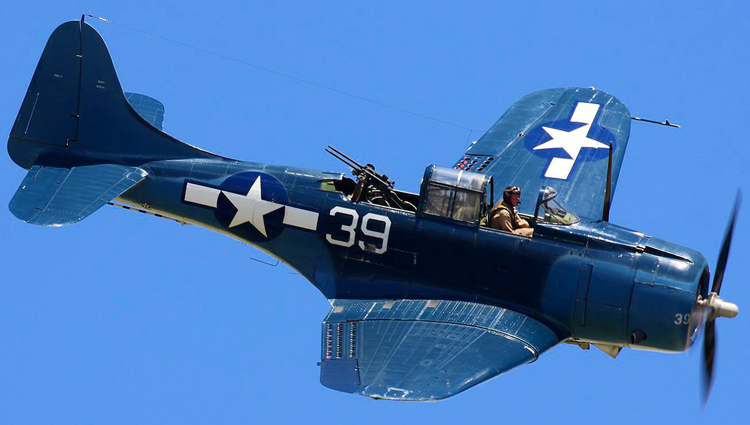 US
Marine Corps Douglas SBD Dauntless Close Air Support
US
Marine Corps Douglas SBD Dauntless Close Air Support
Fortunately,
on 31 January Gen MacArthur gave MAGSD opportunity to prove the utility
of Close Air Support. General MacArthur ordered the 1st Cavalry
division to make an audacious advance of 100 miles to Manila and free
the internees at Santo Tomas. The assignment of MAGSD was a unique
mission of guarding the 1st Cavalry Division flank with a standing nine
plane patrol from dawn until dusk. With some "superior salesmanship and
a determination to show the soldiers what Marine flyers, under proper
front line control could do for them," the MAGSD was able to attach two
Marine Air Liaison Party (ALP) jeeps to follow the 1st and 2nd Brigades
of the 1st Cavalry. The standing nine plane patrol reconnoitered ahead
of the flying column spotting the Japanese positions and routing the
forces around ambushes.
On 2 February 1945, a portion of the Cavalry
was blocked by a Japanese battalion which occupied a ridge that was
reported to withstand an entire division. The attached ALP was able to
call the SBD patrol to complete multiple shows of force and allowed the
Cavalry to route the Japanese without the SBDs firing a shot. The same
day the SBD patrol completed an ad-hoc bombing run ahead of the 1st
Cavalry line in which all bombs landed within a 200 by 300-yard area
and left the target in shambles. Finally, the ALP demonstrated the
increased speed of communication when a Regimental commander dashed to
one of the MAG ALP jeeps to report a Japanese fighter in the area. An
officer in the ALP pointed to a burning fighter 2,000 yards away which
had been destroyed by two P-51s the ALP had vectored in. Within 66
hours the 1st Cavalry arrived in Manila, and the Marines of both MAG-24
and MAG-32 had proven their ability to make the innovative changes in
Close Air Support work. The MAGs received commendations from both the
Brigades and the CG of the 1st Cavalry. However, the division historian
summed up the Marines contribution the best: "Much of the success of
the entire movement is credited to the superb air cover, flank
protection, and reconnaissance provided by Marine Air Groups
24 and
32."
|
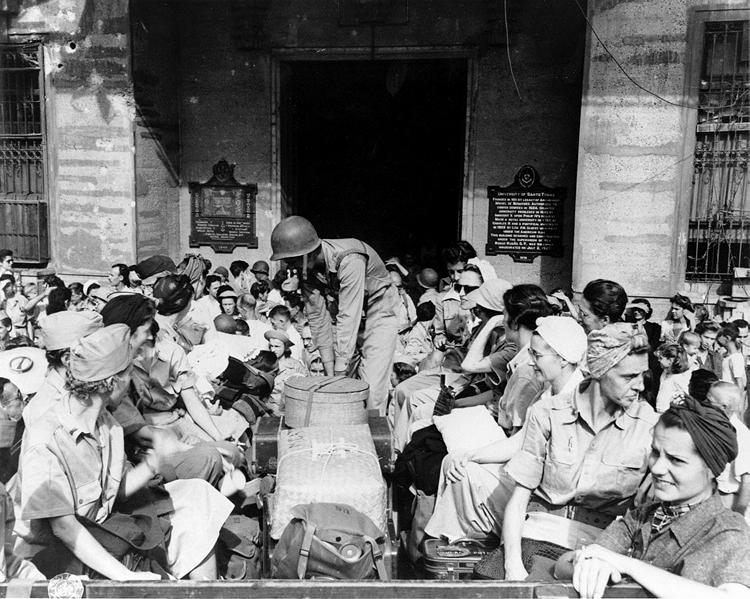
US
Army Nurses Liberated February 3, 1945 |
| The
Battle of Manila, which raged throughout the month of February 1945,
cost the lives of over 100,000 Filipinos and completely destroyed
Manila, considered one of the most beautiful cities in the world at the
time and commonly referred to as the Pearl of the Orient. According to
General MacArthur, next to Warsaw, Manila was the most devastated city
in WWII. It is ironic that whereas Hitler’s order to burn Paris went
unheeded, thereby saving Paris, General Yamashita’s command to leave
Manila without defending it, which would have saved the city, was also
disobeyed, but with contrasting and devastating consequences. Yamashita
was tried at the U.S. High Commissioner’s Residence – now the U.S.
Embassy in Manila – and later hanged for war crimes. |
Los
Banos Internment Camp Rescue
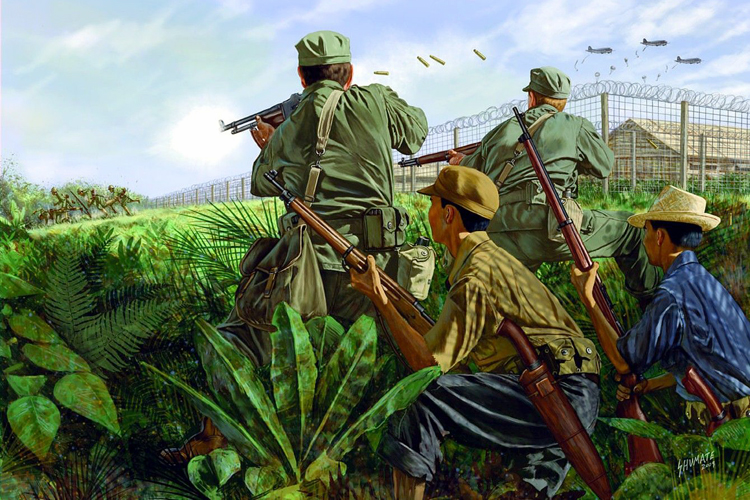 |
| US Navy Nurses Liberated February 23, 1945 |
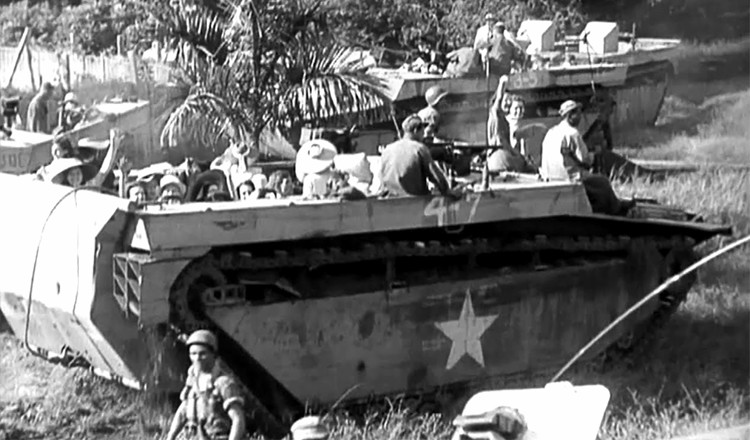 |
| LVT-4, Landing Vehicle Tracked (Amtrac) |
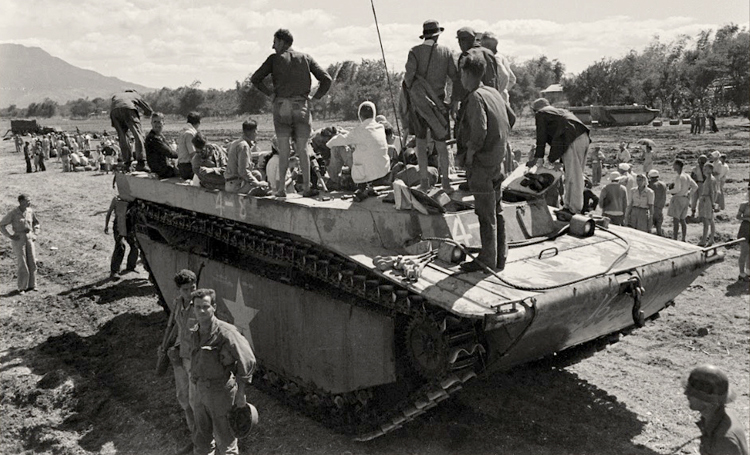 |
| Amtrac Amphibious Assault Vehicles |
 |
| |
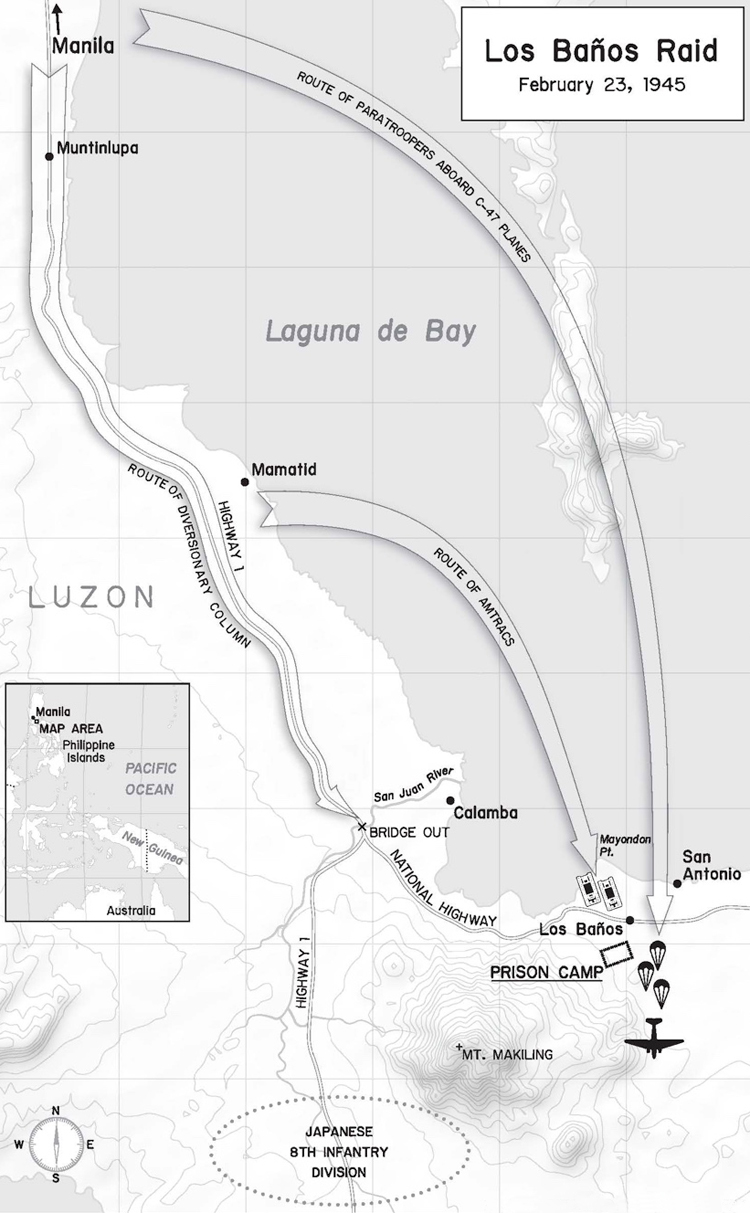 |
The
civilian internment camp near Los Banos had been established by the
Japanese in December 1942 at the Agricultural College of the University
of the Philippines, located about 2 1/2 miles southeast of the town.
Held within the large, fenced compound of more than 30 buildings were
2,147 internees of various nationalities, including 1,575 Americans.
The raid on
Los Banos, located 40 miles behind Japanese lines
would entail a four-pronged attack. The 511th PIR Provisional
Reconnaissance Platoon under Lieutenant George E. Skau, aided by local
guerrillas, would move into an area opposite the camp prior to the
strike. Then, simultaneous with a parachute drop of Lieutenant John M.
Ringler’s Company B of the 511th PIR and an amphibious landing by Major
Henry A. Burgess’s 1st Battalion, minus the airdropped company but
reinforced with a platoon from C Company, 127th Airborne Engineer
Battalion and two howitzers from Battery D, 457th Parachute Field
Artillery Battalion, the recon platoon and guerrillas would eliminate
the sentries along the wire.
While the amphibious force, landing
in LVT-4 amphibious tractors or amtracs of the 672nd Amphibious Tractor
Battalion rolled up onto the beach from Laguna de Bay and continued
toward the camp, the company of paratroopers would link up with the
recon platoon and guerrillas and wipe out the rest of the garrison.
When the amphibious force reached the camp, it would deploy to the
south and west to block any reaction by the Japanese.
The fourth
force would form a flying column composed of the 1st Battalion, 188th
Glider Infantry Regiment, commanded by Lt. Col. Ernie LaFlamme, the
675th Glider Field Artillery Battalion, the 472nd Glider Field
Artillery Battalion, and Company B of the 637th Tank Destroyer
Battalion and move by road around the southwest end of Laguna de Bay up
to the gates of the camp. This force, under the command of Lt. Col.
Robert H. Soule and designated “Los Banos Force,” would bring enough
trucks with it to carry out all the internees and paratroopers. If the
fourth group could not reach the camp, the internees could be ferried
out in the amtracs across Laguna de Bay while the paratroopers fought
their way out. The raid was scheduled for dawn on February 23, 1945, a
moonless night. |
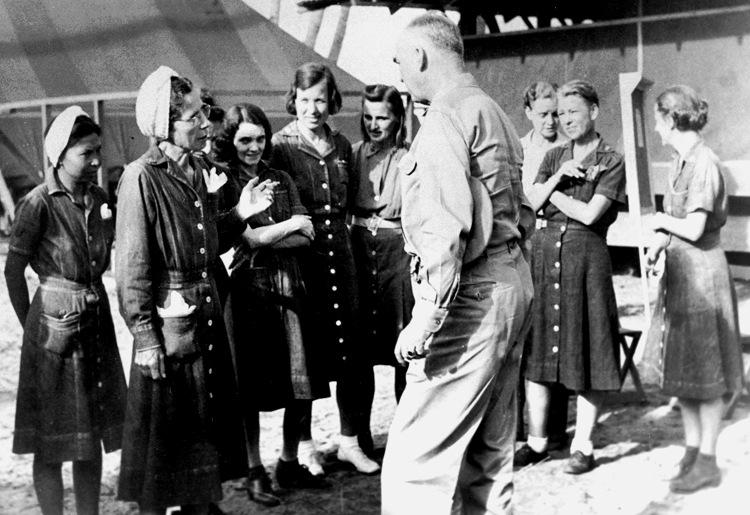 |
| Liberated US Navy Nurses with Admiral Kincaid |
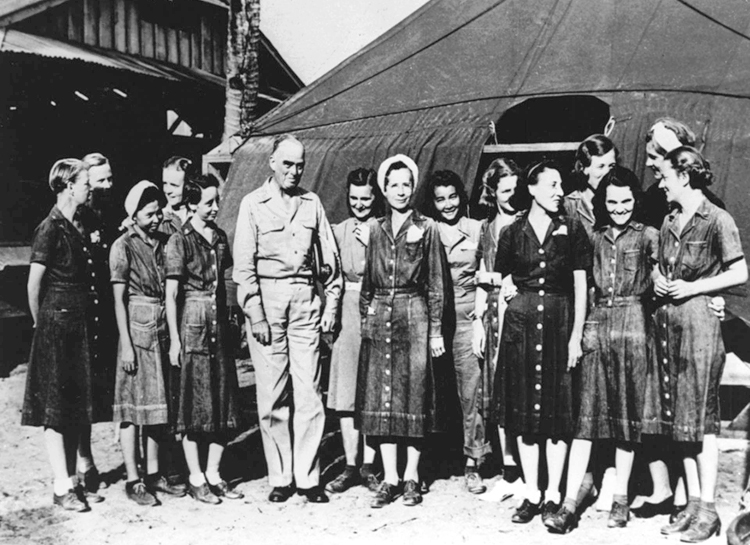 |
| |
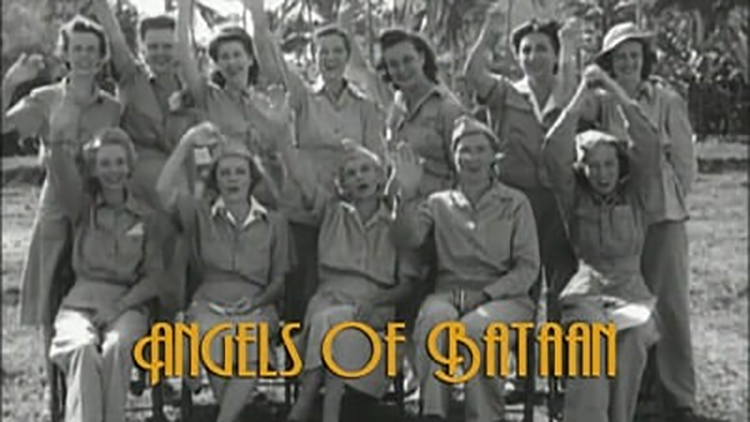 |
| |
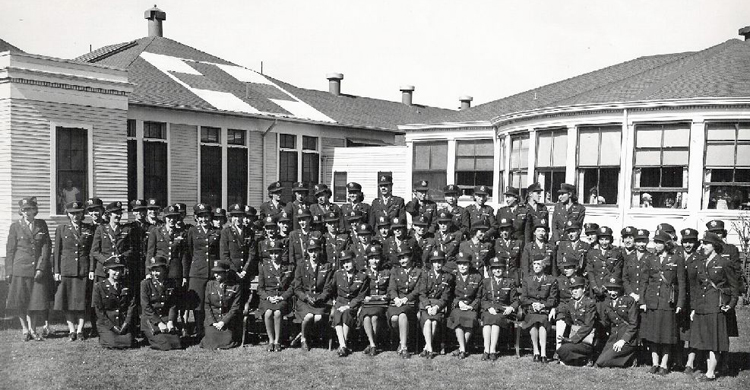 |
| |
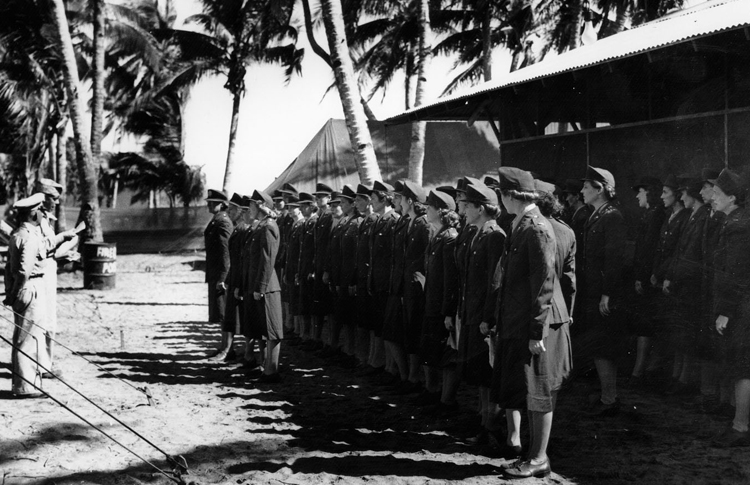 |
| Liberated US Army Nurses Receive Bronze Star Medals |
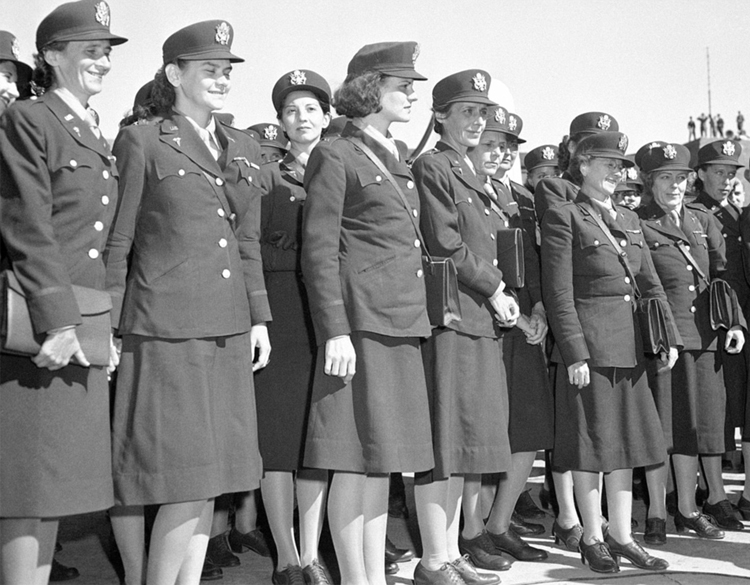
|
| |
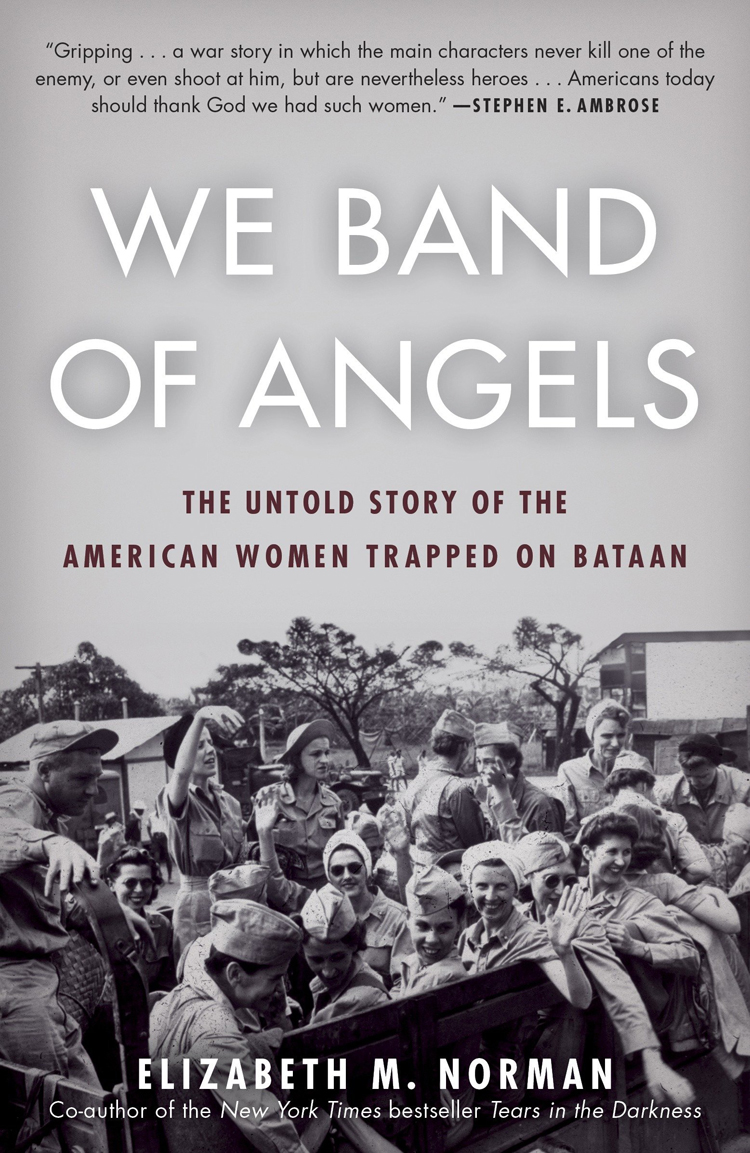 |
We
Band of Angels
Elizabeth Norman |
In
December 1941, American bases in the Philippines were caught in a
raging battle when Japanese forces attacked. Nurses set up field
hospitals in the jungles of Bataan and the tunnels of Corregidor, where
they tended to the most devastating injuries of war. They later endured
three years of fear, brutality and starvation in internment camps.
Once
liberated, they returned to an America that at first celebrated them,
but later refused to honor their leaders. Norman reveals the letters,
diaries and riveting firsthand accounts that explain what really
happened during those dark days, woven together in a deeply affecting
saga of women in war.
Elizabeth Norman is a professor at New York University’s Steinhardt
School of Culture, Education, and Human Development. She is the author
of “Women at War: The Story of Fifty Military Nurses Who Served in
Vietnam 1965-1973”, “We Band of Angels: The Untold Story of American
Women Trapped on Bataan by the Japanese” and co-author with her
husband, Marine Corps Veteran and former New York Times reporter,
Michael Norman of “Tears in the Darkness: The Story of the Bataan Death
March and Its Aftermath”. The book was on the New York Times
best-seller list for nine weeks and a Dayton Literary Peace Prize
finalist.
Norman’s awards include the American Academy of
Nursing National Media Award, The University of Virginia Agnes Dillon
Award, a Certificate of Appreciation from the Embassy of the
Philippines in Washington, D.C. and an Official Commendation from the
Department of the Army for her military research. |
| |
| Angels of Bataan Films |
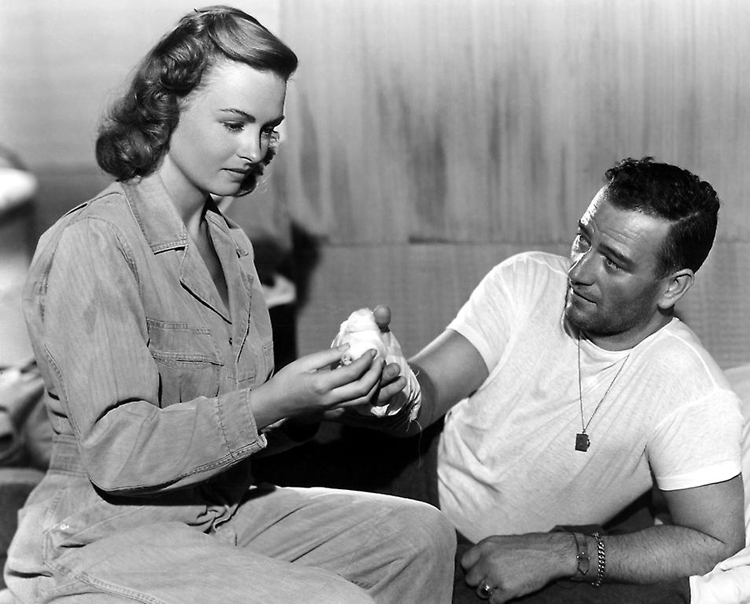 |
Donna
Reed and John Wayne
They Were Expendable 1945 |
| US
Army Nurse cares for wounded in Malinta Tunnel on Corregidor Island,
the Philippines
after Imperial Japanese attack and before transfer to Bataan Peninsula. |
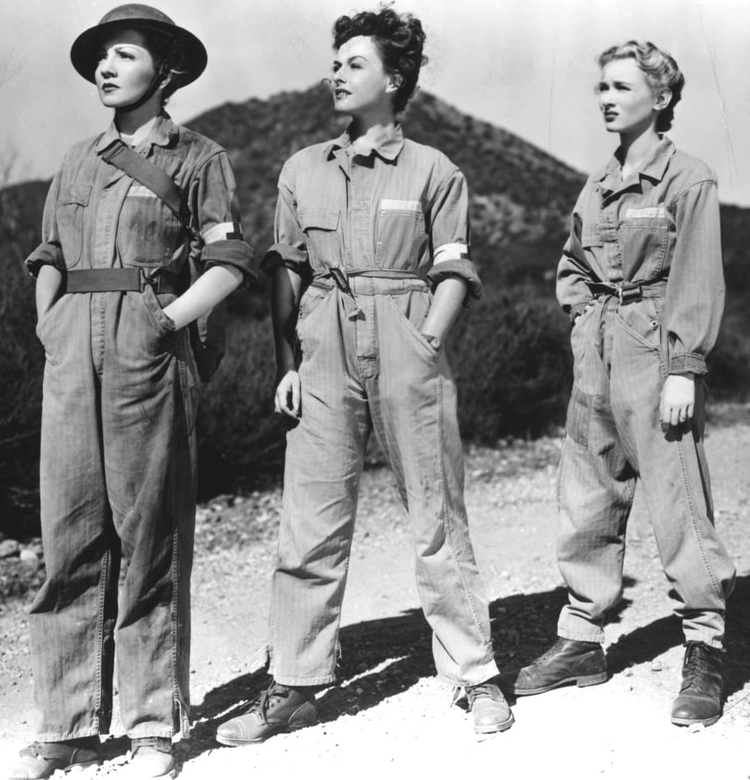 |
Claudette
Colbert
Paulette Goddard
Veronica Lake
So Proudly We Hail 1943 |
| At
the start of World War II in the Pacific, Lieutenant Janet Davidson
(Claudette Colbert) is the head of a group of U.S. military nurses who
are trapped behind enemy lines in the Philippines. |
|
Landing Vehicle Tracked
LVT Tour
US Marine Corps
1952 TV Program
Written by Member of the
Last China Band,
WWII POW, and Bronze Star Medal
with "V" Device Recipient,
First Lieutenant George Francis, USMC, Retired
80 Years Since Attack on
Pearl
Harbor and the Philippines
December 7, 2021 |
 |
| Last China Band Digital Card |
Copy and paste to a text or email.
Below is a printable version
with eighth inch trim edges: |
Last_China_Band
Business_Card.pdf |
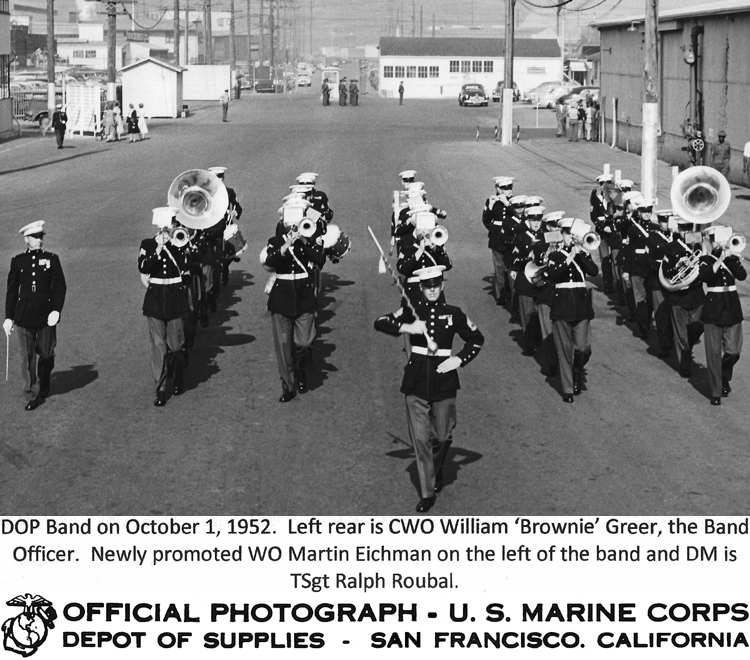 |
Last
China Band Members and Former World War II Prisoners of War Martin
Eichman, Jack P. Rauhof, Kenneth Marshall and Other Late 1940's and
1950's USMC Bands Original Photo Prints from Third Marine Aircraft Wing
Band, 3rd MAW, Miramar Marine Corps Air Station, San Diego, CA and
Marine Corps Musicians Association Historian
Band Photos After WWII
Miramar 3D MAW Band
|
| Please Click Below For: |
| Return
to Additional Photos Page |
| |
Return
to Books / Photos Page
EMAIL:
info@4thMarinesBand.com
714-227-5741
©2000-2023 LastChinaBand.com
All rights reserved. |
|
